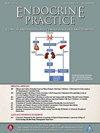Nasolacrimal Duct Obstruction Following Radioactive Iodine: An Update on Counseling Recommendations for Thyroid Cancer Survivors
IF 3.7
3区 医学
Q2 ENDOCRINOLOGY & METABOLISM
引用次数: 0
Abstract
Objective
Radioactive iodine (RAI) treatment for thyroid carcinoma may induce nasolacrimal duct obstruction. Evidence-based recommendations regarding nasolacrimal screening and prophylactic management in thyroid cancer survivors are lacking.
Methods
A case control study of patients treated with radioactive iodine for thyroid carcinoma was performed, comparing those who developed symptomatic nasolacrimal duct obstruction (group 1) to age- and gender-matched controls who did not develop nasolacrimal duct obstruction (group 2), to identify risk factors.
Results
Fifty patients with history of RAI treatment for thyroid carcinoma were reviewed, including 25 patients who subsequently developed epiphora and were diagnosed with nasolacrimal duct obstruction, and 25 age- and gender-matched RAI-treated patients who did not develop nasolacrimal duct obstruction. The mean cumulative RAI dose was 223.4 mCi (8.27 Gbq) for group 1 and 121.4 mCi (4.49 Gbq) for group 2 (P = .0092). The mean initial treatment dose was 128.9 mCi (4.77 Gbq) and 100.0 mCi (3.70 Gbq) for the 2 groups, respectively (P = .0317). The mean number of RAI treatment sessions in patients who developed nasolacrimal duct obstruction was 1.48 (range 1-3), compared to 1.16 (range 1-2) in the group that did not (P = .0387).
Conclusions
Higher initial and cumulative treatment dose of RAI, and multiple treatment sessions, increased likelihood of subsequent development of nasolacrimal duct obstruction. We recommend increased counseling and screening of thyroid cancer survivors undergoing RAI for thyroid carcinoma at lower doses than previously indicated, particularly in those who undergo multiple treatment sessions.
放射性碘导致的鼻泪管阻塞:甲状腺癌幸存者咨询建议的最新进展。
目的放射性碘治疗甲状腺癌可能诱发鼻泪管阻塞。关于甲状腺癌幸存者的鼻泪管筛查和预防性管理,目前还缺乏基于证据的建议:方法:对接受放射性碘治疗的甲状腺癌患者进行病例对照研究,将出现症状性鼻泪管阻塞的患者(第1组)与未出现鼻泪管阻塞的年龄和性别匹配的对照组(第2组)进行比较,以确定风险因素:对50名曾接受甲状腺癌放射性碘治疗的患者进行了复查,其中25名患者随后出现了外窥症状并被诊断为鼻泪管阻塞,另外25名年龄和性别匹配的接受过RAI治疗的患者未出现鼻泪管阻塞。第一组的 RAI 平均累积剂量为 223.4 mCi(8.27 Gbq),第二组为 121.4 mCi(4.49 Gbq)(p = 0.0092)。两组的平均初始治疗剂量分别为 128.9 mCi(4.77 Gbq)和 100.0 mCi(3.70 Gbq)(p = 0.0317)。出现鼻泪管阻塞的患者接受放射性碘治疗的平均次数为1.48次(1-3次不等),而未出现鼻泪管阻塞的患者接受放射性碘治疗的平均次数为1.16次(1-2次不等)(p = 0.0387):结论:较高的放射性碘初始治疗剂量和累积治疗剂量以及多次治疗会增加随后发生鼻泪管阻塞的可能性。我们建议对接受放射性碘治疗甲状腺癌的甲状腺癌幸存者进行更多的咨询和筛查,尤其是那些接受多次治疗的幸存者。
本文章由计算机程序翻译,如有差异,请以英文原文为准。
求助全文
约1分钟内获得全文
求助全文
来源期刊

Endocrine Practice
ENDOCRINOLOGY & METABOLISM-
CiteScore
7.60
自引率
2.40%
发文量
546
审稿时长
41 days
期刊介绍:
Endocrine Practice (ISSN: 1530-891X), a peer-reviewed journal published twelve times a year, is the official journal of the American Association of Clinical Endocrinologists (AACE). The primary mission of Endocrine Practice is to enhance the health care of patients with endocrine diseases through continuing education of practicing endocrinologists.
 求助内容:
求助内容: 应助结果提醒方式:
应助结果提醒方式:


